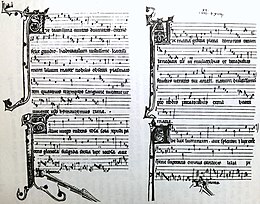
The Montpellier Codex (Montpellier, Bibliothèque Inter-Universitaire, Section Médecine, H196) is an important source of 13th-century French polyphony. The Codex contains 336 polyphonic works probably composed c. 1250–1300, and was likely compiled c. 1300.[1] It is believed to originate from Paris. It was discovered by musicologist Edmond de Coussemaker in c. 1852.[2][3]
- ^ Grove: "Date: fascs.2–6, 1270s (Rosketh and RISM, c1280); fascs.1 and 7, plus the additions to 3 and 5, very end of 13th century (Branner: late 13th century, Everist: 1280s); fasc.8, very early years of the 14th century (Branner and Everist: c1300). As a controversial alternative to the picture of a manuscript compiled in discrete stages of activity a decade or more apart, Wolinski posits a single campaign of copying fascs.1–7 as an entity in the 1260s or 1270s, with fasc.8 perhaps also as early as the 1270s; not widely accepted, her theory has radical implications for the development of the motet, musical notation and music theory in the second half of the 13th century (Wolinski, 1992, pp.299–301)."
- ^ Emil Naumann Illustrierte Musikgeschichte., Volume 2, Spemann, Berlin & Stuttgart 1886.
- ^ Pierre Combe The Restoration of Gregorian Chant: Solesmes and the Vatican Edition, CUA Press, 2008, p. 13f